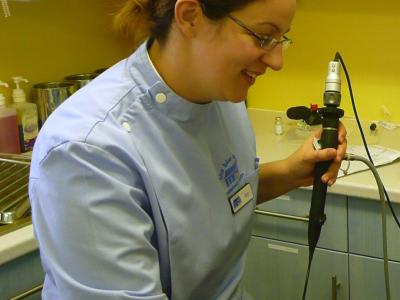Diagnostic Laboratory Services
Fast results - our in-house blood sample machine can produce results within 10 minutes, allowing rapid assessment of sick pets, and can also provide sameday screening and monitoring tests. Testing of urine and skin samples will often be performed on site by our experienced clinical team.
This is complimented by the use of external specialist laboratories for specific expert advice, and services such as detailed hormone testing, allergy testing or analysing tissue samples or cells. The majority of the labs we use offer a rapid turnaround and results will often be available within 24 hours of submission.

Diagnostic Imaging Radiography (X-rays)
X-rays are an invaluable diagnostic tool allowing non invasive imaging of your pet. At Blue House we have a modern, powerful X-ray machine with a ‘floating bed table’ allowing us to take X-rays of the smallest hamster to a 100kg Great Dane. A very speedy digital developer allows us to process X-Ray films in just 90 seconds reducing anaesthetic times for your pet.

Dental X-rays
Our dental X-ray machine has a small mobile head and so allows us to take X-rays within the mouth of your pet. X-ray films, developed within seconds, allow us to assess suspicious teeth above and below the gum line and make accurate decisions on the best treatment options. We believe that veterinary dentistry, just like human dentistry, should be performed based on the ability to image the whole tooth. After all, the crown of the tooth - the bit we see inside our pet’s mouth - is just the like the tip of an iceberg. It’s what we can’t see with the naked eye that might be a problem. We have also found this X-ray machine useful for taking X-rays of broken toes and nasal cavities.
Click Here to view our Dentistry page
Ultrasound
Ultrasound is a painless, non-invasive imaging technique, which uses sound waves sent from a probe to create an image of the soft tissues of the body in the region where the probe is applied. We have to apply the probe to bare skin, and so we may clip a small area of fur where a special gel is applied to conduct the sound waves. At Blue House we have an advanced ultrasound machine capable of producing detailed images, which can be captured digitally. Measurements can be taken in several different directions and the outline of internal structures can be traced.
Using a facility known as Colour Flow Doppler, we are also able to identify blood vessels and structures of the heart, ‘seeing’ the blood flow within. The ultrasound machine can also be linked to an ECG so that further assessment of the heart can be made.
Just as it is in human medicine, ultrasound can be used to diagnose and assess pregnancy allowing us to help you with planning and decision making for your pet. We also use ultrasound to image eyes, abdominal organs and various lumps and bumps, providing more information for our treatment plans.

Electrocardiogram (ECG)
At Blue House we have a modern digital ECG which produces immediate readings on a digital screen and can also provide us with a paper trace for further interpretation. An ECG is a record of the electrical activity of the heart, and measurements taken from these are used to help us assess the rate and rhythm of your pet’s heart. The recording is obtained by attaching small electrical leads to your pet whilst they are lying calmly on a soft bed. ECG is essential for the accurate diagnosis of heart rhythm abnormalities, which can be serious and potentially life threatening. Digital or hard copies of the results can be quickly sent to our visiting specialist Mike Holgate for expert interpretation if needed.

Tonometry (eye pressure measurement)
The vets at Blue House use a Tonopen, a highly sensitive probe which is applied directly to your pet's eyeball. This clever device allows us to take a reading of the pressure within the eyeball. This is a procedure often performed in specialist eye clinics, for which patients would have previously had to be referred, involving travel.
Testing the pressure in your pet’s eye allows us to rapidly diagnose or rule out conditions where there is increased pressure within the eyeball, such as glaucoma. These conditions can be painful and your pet’s sight may be threatened requiring immediate treatment. We also use tonometry for ongoing monitoring so we can assess response to treatment.